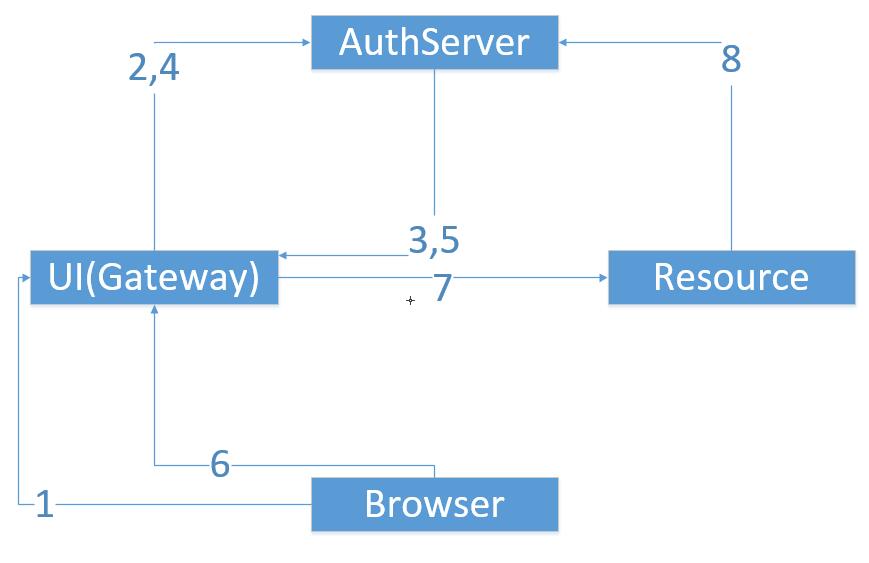Spring Security Oauth2 單點登入案例實現和執行流程剖析
線上演示
演示地址:http://139.196.87.48:9002/kitty
使用者名稱:admin 密碼:admin
Spring Security Oauth2
OAuth是一個關於授權的開放網路標準,在全世界得到的廣泛的應用,目前是2.0的版本。OAuth2在“客戶端”與“服務提供商”之間,設定了一個授權層(authorization layer)。“客戶端”不能直接登入“服務提供商”,只能登入授權層,以此將使用者與客戶端分離。“客戶端”登入需要獲取OAuth提供的令牌,否則將提示認證失敗而導致客戶端無法訪問服務。關於OAuth2這裡就不多作介紹了,網上資料詳盡。下面我們實現一個 整合 SpringBoot 、Spring Security OAuth2 來實現單點登入功能的案例並對執行流程進行詳細的剖析。
案例實現
專案介紹
這個單點登入系統包括下面幾個模組:
spring-oauth-parent : 父模組,管理打包
spring-oauth-server : 認證服務端、資源服務端(埠:8881)
spring-oauth-client : 單點登入客戶端示例(埠:8882)
spring-oauth-client2: 單點登入客戶端示例(埠:8883)
當通過任意客戶端訪問資源伺服器受保護的介面時,會跳轉到認證伺服器的統一登入介面,要求登入,登入之後,在登入有效時間內任意客戶端都無需再登入。
認證服務端
新增依賴
主要是新增 spring-security-oauth2 依賴。
pom.xml
<project xmlns="http://maven.apache.org/POM/4.0.0" xmlns:xsi="http://www.w3.org/2001/XMLSchema-instance"
xsi:schemaLocation="http://maven.apache.org/POM/4.0.0 http://maven.apache.org/xsd/maven-4.0.0.xsd">
<modelVersion>4.0.0</modelVersion>
<artifactId>spring-oauth-server</artifactId>
<name>spring-oauth-server</name>
<packaging>war</packaging>
<parent>
<groupId>com.louis</groupId>
<artifactId>spring-oauth-parent</artifactId>
<version>1.0.0-SNAPSHOT</version>
</parent>
<dependencies>
<dependency>
<groupId>org.springframework.boot</groupId>
<artifactId>spring-boot-starter-web</artifactId>
</dependency>
<dependency>
<groupId>org.springframework.security.oauth</groupId>
<artifactId>spring-security-oauth2</artifactId>
<version>${oauth.version}</version>
</dependency>
<dependency>
<groupId>org.springframework.boot</groupId>
<artifactId>spring-boot-starter-freemarker</artifactId>
</dependency>
</dependencies>
</project>配置檔案
配置檔案內容如下。
application.yml
server:
port: 8881
servlet:
context-path: /auth
啟動類
啟動類新增 @EnableResourceServer 註解,表示作為資源伺服器。
OAuthServerApplication.java
package com.louis.spring.oauth.server;
import org.springframework.boot.SpringApplication;
import org.springframework.boot.autoconfigure.SpringBootApplication;
import org.springframework.boot.web.servlet.support.SpringBootServletInitializer;
import org.springframework.security.oauth2.config.annotation.web.configuration.EnableResourceServer;
@SpringBootApplication
@EnableResourceServer
public class OAuthServerApplication extends SpringBootServletInitializer { public static void main(String[] args) { SpringApplication.run(OAuthServerApplication.class, args); } }
認證服務配置
新增認證伺服器配置,這裡採用記憶體方式獲取,其他方式獲取在這裡定製即可。
OAuthServerConfig.java
package com.louis.spring.oauth.server.config; import org.springframework.beans.factory.annotation.Autowired; import org.springframework.context.annotation.Configuration; import org.springframework.security.crypto.bcrypt.BCryptPasswordEncoder; import org.springframework.security.oauth2.config.annotation.configurers.ClientDetailsServiceConfigurer; import org.springframework.security.oauth2.config.annotation.web.configuration.AuthorizationServerConfigurerAdapter; import org.springframework.security.oauth2.config.annotation.web.configuration.EnableAuthorizationServer; import org.springframework.security.oauth2.config.annotation.web.configurers.AuthorizationServerSecurityConfigurer; @Configuration @EnableAuthorizationServer public class OAuthServerConfig extends AuthorizationServerConfigurerAdapter { @Autowired private BCryptPasswordEncoder passwordEncoder; @Override public void configure(final AuthorizationServerSecurityConfigurer oauthServer) throws Exception { oauthServer.tokenKeyAccess("permitAll()").checkTokenAccess("isAuthenticated()"); } @Override public void configure(final ClientDetailsServiceConfigurer clients) throws Exception { clients.inMemory() .withClient("SampleClientId") // clientId, 可以類比為使用者名稱 .secret(passwordEncoder.encode("secret")) // secret, 可以類比為密碼 .authorizedGrantTypes("authorization_code") // 授權型別,這裡選擇授權碼 .scopes("user_info") // 授權範圍 .autoApprove(true) // 自動認證 .redirectUris("http://localhost:8882/login","http://localhost:8883/login") // 認證成功重定向URL .accessTokenValiditySeconds(10); // 超時時間,10s } }
安全配置
Spring Security 安全配置。在安全配置類裡我們配置了:
1. 配置請求URL的訪問策略。
2. 自定義了同一認證登入頁面URL。
3. 配置使用者名稱密碼資訊從記憶體中建立並獲取。
SecurityConfig.java
package com.louis.spring.oauth.server.config; import org.springframework.context.annotation.Bean; import org.springframework.context.annotation.Configuration; import org.springframework.core.annotation.Order; import org.springframework.security.config.annotation.authentication.builders.AuthenticationManagerBuilder; import org.springframework.security.config.annotation.web.builders.HttpSecurity; import org.springframework.security.config.annotation.web.configuration.WebSecurityConfigurerAdapter; import org.springframework.security.crypto.bcrypt.BCryptPasswordEncoder; @Configuration @Order(1) public class SecurityConfig extends WebSecurityConfigurerAdapter { @Override protected void configure(HttpSecurity http) throws Exception { http.requestMatchers() .antMatchers("/login") .antMatchers("/oauth/authorize") .and() .authorizeRequests() .anyRequest().authenticated() .and() .formLogin().loginPage("/login").permitAll() // 自定義登入頁面,這裡配置了 loginPage, 就會通過 LoginController 的 login 介面載入登入頁面 .and().csrf().disable(); } @Override protected void configure(AuthenticationManagerBuilder auth) throws Exception { // 配置使用者名稱密碼,這裡採用記憶體方式,生產環境需要從資料庫獲取 auth.inMemoryAuthentication() .withUser("admin") .password(passwordEncoder().encode("123")) .roles("USER"); } @Bean public BCryptPasswordEncoder passwordEncoder(){ return new BCryptPasswordEncoder(); } }
介面提供
這裡提供了一個自定義的登入介面,用於跳轉到自定義的同一認證登入頁面。
LoginController.java
package com.louis.spring.oauth.server.controller; import org.springframework.stereotype.Controller; import org.springframework.web.bind.annotation.GetMapping; @Controller public class LoginController { /** * 自定義登入頁面 * @return */ @GetMapping("/login") public String login() { return "login"; } }
登入頁面放置在 resources/templates 下,需要在登入時提交 pos t表單到 auth/login。
login.ftl
<!DOCTYPE html>
<html>
<head>
<meta charset="UTF-8">
<title>Insert title here</title>
<link rel="stylesheet" href="https://unpkg.com/element-ui/lib/theme-chalk/index.css">
<script src="https://cdn.bootcss.com/vue/2.5.17/vue.min.js"></script>
<script src="https://unpkg.com/element-ui/lib/index.js"></script>
<script src="https://cdn.bootcss.com/jquery/3.3.1/jquery.js"></script>
</head>
<body>
<div class="login-box" id="app" >
<el-form action="/auth/login" method="post" label-position="left" label-width="0px" class="demo-ruleForm login-container">
<h2 class="title" >統一認證登入平臺</h2>
<el-form-item>
<el-input type="text" name="username" v-model="username" auto-complete="off" placeholder="賬號"></el-input>
</el-form-item>
<el-form-item>
<el-input type="password" name="password" v-model="password" auto-complete="off" placeholder="密碼"></el-input>
</el-form-item>
<el-form-item style="width:100%; text-align:center;">
<el-button type="primary" style="width:47%;" @click.native.prevent="reset">重 置</el-button>
<el-button type="primary" style="width:47%;" native-type="submit" :loading="loading">登 錄</el-button>
</el-form-item>
<el-form>
</div>
</body>
<script type="text/javascript">
new Vue({
el : '#app',
data : {
loading: false,
username: 'admin',
password: '123'
},
methods : {
}
})
</script>
<style lang="scss" scoped>
.login-container {
-webkit-border-radius: 5px;
border-radius: 5px;
-moz-border-radius: 5px;
background-clip: padding-box;
margin: 100px auto;
width: 320px;
padding: 35px 35px 15px 35px;
background: #fff;
border: 1px solid #eaeaea;
box-shadow: 0 0 25px #cac6c6;
}
.title {
margin: 0px auto 20px auto;
text-align: center;
color: #505458;
}
</style>
</html>
這裡提供了一個受保護的介面,用於獲取使用者資訊,客戶端訪問這個介面的時候要求登入認證。
UserController.java
package com.louis.spring.oauth.server.controller; import java.security.Principal; import org.springframework.web.bind.annotation.RequestMapping; import org.springframework.web.bind.annotation.RestController; @RestController public class UserController { /** * 資源伺服器提供的受保護介面 * @param principal * @return */ @RequestMapping("/user") public Principal user(Principal principal) { System.out.println(principal); return principal; } }
客戶端實現
新增依賴
主要新增 Spring Security 依賴,另外因為 Spring Boot 2.0 之後程式碼的合併, 需要新增 spring-security-oauth2-autoconfigure ,才能使用 @EnableOAuth2Sso 註解。
pom.xml
<project xmlns="http://maven.apache.org/POM/4.0.0" xmlns:xsi="http://www.w3.org/2001/XMLSchema-instance"
xsi:schemaLocation="http://maven.apache.org/POM/4.0.0 http://maven.apache.org/xsd/maven-4.0.0.xsd">
<modelVersion>4.0.0</modelVersion>
<artifactId>spring-oauth-client</artifactId>
<name>spring-oauth-client</name>
<packaging>war</packaging>
<parent>
<groupId>com.louis</groupId>
<artifactId>spring-oauth-parent</artifactId>
<version>1.0.0-SNAPSHOT</version>
</parent>
<dependencies>
<dependency>
<groupId>org.springframework.boot</groupId>
<artifactId>spring-boot-starter-web</artifactId>
</dependency>
<dependency>
<groupId>org.springframework.boot</groupId>
<artifactId>spring-boot-starter-security</artifactId>
</dependency>
<dependency>
<groupId>org.springframework.security.oauth.boot</groupId>
<artifactId>spring-security-oauth2-autoconfigure</artifactId>
<version>${oauth-auto.version}</version>
</dependency>
<dependency>
<groupId>org.springframework.boot</groupId>
<artifactId>spring-boot-starter-thymeleaf</artifactId>
</dependency>
<dependency>
<groupId>org.thymeleaf.extras</groupId>
<artifactId>thymeleaf-extras-springsecurity4</artifactId>
</dependency>
</dependencies>
</project>
啟動類
啟動類需要新增 RequestContextListener,用於監聽HTTP請求事件。
OAuthClientApplication.java
package com.louis.spring.oauth.client;
import org.springframework.boot.SpringApplication;
import org.springframework.boot.autoconfigure.SpringBootApplication;
import org.springframework.boot.web.servlet.support.SpringBootServletInitializer;
import org.springframework.context.annotation.Bean;
import org.springframework.web.context.request.RequestContextListener; @SpringBootApplication public class OAuthClientApplication extends SpringBootServletInitializer { @Bean public RequestContextListener requestContextListener() { return new RequestContextListener(); } public static void main(String[] args) { SpringApplication.run(OAuthClientApplication.class, args); } }
安全配置
新增安全配置類,新增 @EnableOAuth2Sso 註解支援單點登入。
OAuthClientSecurityConfig.java
package com.louis.spring.oauth.client.config; import org.springframework.boot.autoconfigure.security.oauth2.client.EnableOAuth2Sso; import org.springframework.context.annotation.Configuration; import org.springframework.security.config.annotation.web.builders.HttpSecurity; import org.springframework.security.config.annotation.web.configuration.WebSecurityConfigurerAdapter; @EnableOAuth2Sso @Configuration public class OAuthClientSecurityConfig extends WebSecurityConfigurerAdapter { @Override public void configure(HttpSecurity http) throws Exception { http.csrf().disable() .antMatcher("/**") .authorizeRequests() .antMatchers("/", "/login**") .permitAll() .anyRequest() .authenticated(); } }
頁面配置
新增 Spring MVC 配置,主要是新增 index 和 securedPage 頁面對應的訪問配置。
OAuthClientWebConfig.java
package com.louis.spring.oauth.client.config;
import org.springframework.context.annotation.Bean;
import org.springframework.context.annotation.Configuration;
import org.springframework.context.support.PropertySourcesPlaceholderConfigurer;
import org.springframework.web.servlet.config.annotation.*;
@Configuration
@EnableWebMvc
public class OAuthClientWebConfig implements WebMvcConfigurer { @Bean public static PropertySourcesPlaceholderConfigurer propertySourcesPlaceholderConfigurer() { return new PropertySourcesPlaceholderConfigurer(); } @Override public void configureDefaultServletHandling(final DefaultServletHandlerConfigurer configurer) { configurer.enable(); } @Override public void addViewControllers(final ViewControllerRegistry registry) { registry.addViewController("/") .setViewName("forward:/index"); registry.addViewController("/index"); registry.addViewController("/securedPage"); } @Override public void addResourceHandlers(final ResourceHandlerRegistry registry) { registry.addResourceHandler("/resources/**") .addResourceLocations("/resources/"); } }
配置檔案
主要配置 oauth2 認證相關的配置。
application.yml
auth-server: http://localhost:8881/auth server: port: 8882 servlet: context-path: / session: cookie: name: SESSION1 security: basic: enabled: false oauth2: client: clientId: SampleClientId clientSecret: secret accessTokenUri: ${auth-server}/oauth/token userAuthorizationUri: ${auth-server}/oauth/authorize resource: userInfoUri: ${auth-server}/user spring: thymeleaf: cache: false
頁面檔案
頁面檔案只有兩個,index 是首頁,無須登入即可訪問,在首頁通過新增 login 按鈕訪問 securedPage 頁面,securedPage 訪問資源伺服器的 /user 介面獲取使用者資訊。
/resources/templates/index.html
<!DOCTYPE html>
<html lang="en">
<head>
<meta http-equiv="Content-Type" content="text/html; charset=utf-8" />
<title>Spring Security SSO</title>
<link rel="stylesheet"
href="https://maxcdn.bootstrapcdn.com/bootstrap/3.3.2/css/bootstrap.min.css" />
</head>
<body>
<div class="container">
<div class="col-sm-12">
<h1>Spring Security SSO</h1>
<a class="btn btn-primary" href="securedPage">Login</a>
</div>
</div>
</body>
</html>
/resources/templates/securedPage.html
<!DOCTYPE html>
<html lang="en">
<head>
<meta http-equiv="Content-Type" content="text/html; charset=utf-8" />
<title>Spring Security SSO</title>
<link rel="stylesheet"
href="https://maxcdn.bootstrapcdn.com/bootstrap/3.3.2/css/bootstrap.min.css" />
</head>
<body>
<div class="container">
<div class="col-sm-12">
<h1>Secured Page</h1>
Welcome, <span th:text="${#authentication.name}">Name</span>
</div>
</div>
</body>
</html>
spring-oauth-client2 內容跟 spring-oauth-client 基本一樣,除了埠為 8883 外,securedPage 顯示的內容稍微有點不一樣用於區分。
測試效果
啟動認證服務端和客戶端。
訪問 http://localhost:8882/,返回結果如下。
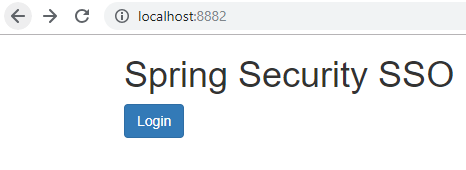
點選 login,跳轉到 securedPage 頁面,頁面呼叫資源伺服器的受保護介面 /user ,會跳轉到認證伺服器的登入介面,要求進行登入認證。
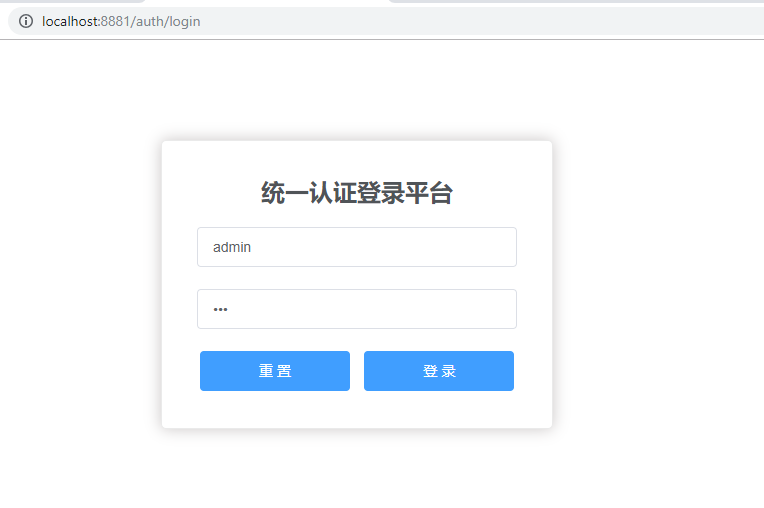
同理,訪問 http://localhost:8883/,返回結果如下。

點選 login,同樣跳轉到認證伺服器的登入介面,要求進行登入認證。

輸入使用者名稱密碼,預設是後臺配置的使用者資訊,使用者名稱:admin, 密碼:123 ,點選登入。
從 http://localhost:8882/ 發出的請求登入成功之後返回8882的安全保護頁面。
如果是從 http://localhost:8883/ 發出的登入請求,則會跳轉到8883的安全保護頁面。
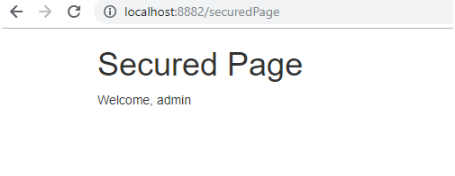
從 8882 發出登入請求,登入成功之後,訪問 http://localhost:8883/ ,點選登入。
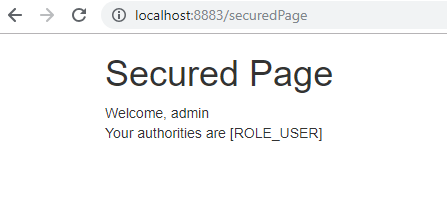
結果不需要再進行登入,直接跳轉到了 8883 的安全保護頁面,因為在訪問 8882 的時候已經登入過了。
同理,假如先訪問 8883 資源進行登入之後,訪問 8882 也無需重複登入,到此,單點登入的案例實現就完成了。
執行流程剖析
接下來,針對上面的單點登入案例,我們對整個體系的執行流程進行詳細的剖析。
在此之前,我們先描述一下OAuth2授權碼模式的整個大致流程。
1. 瀏覽器向UI伺服器點選觸發要求安全認證
2. 跳轉到授權伺服器獲取授權許可碼
3. 從授權伺服器帶授權許可碼跳回來
4. UI伺服器向授權伺服器獲取AccessToken
5. 返回AccessToken到UI伺服器
6. 發出/resource請求到UI伺服器
7. UI伺服器將/resource請求轉發到Resource伺服器
8. Resource伺服器要求安全驗證,於是直接從授權伺服器獲取認證授權資訊進行判斷後(最後會響應給UI伺服器,UI伺服器再響應給瀏覽中器)
結合我們的案例,首先,我們通過 http://localhost:8882/,訪問 8882 的首頁,8883 同理。
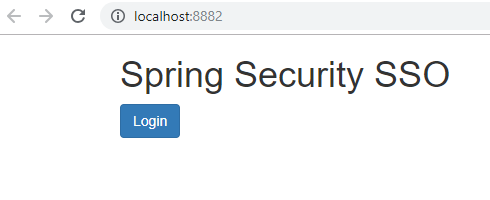
然後點選 Login,重定向到了 http://localhost:8882/securedPage,而 securedPage 是受保護的頁面。所以就重定向到了 8882 的登入URL: http://localhost:8882/login, 要求首先進行登入認證。
因為客戶端配置了單點登入(@EnableOAuth2Sso),所以單點登入攔截器會讀取授權伺服器的配置,發起形如: http://localhost:8881/auth/oauth/authorize?client_id=SampleClientId&redirect_uri=http://localhost:8882/ui/login&response_type=code&state=xtDCY2 的授權請求獲取授權碼。
然後因為上面訪問的是認證伺服器的資源,所以又重定向到了認證伺服器的登入URL: http://localhost:8881/auth/login,也就是我們自定義的統一認證登入平臺頁面,要求先進行登入認證,然後才能繼續傳送獲取授權碼的請求。
我們輸入使用者名稱和密碼,點選登入按鈕進行登入認證。

登入認證的大致流程如下:
AbstractAuthenticationProcessingFilter.doFilter()
預設的登入過濾器 UsernamePasswordAuthenticationFilter 攔截到登入請求,呼叫父類的 doFilter 的方法。
public void doFilter(ServletRequest req, ServletResponse res, FilterChain chain)
throws IOException, ServletException {
...
Authentication authResult;
try {
authResult = attemptAuthentication(request, response);
if (authResult == null) {
// return immediately as subclass has indicated that it hasn't completed
// authentication
return;
}
sessionStrategy.onAuthentication(authResult, request, response);
}
... successfulAuthentication(request, response, chain, authResult); }
UsernamePasswordAuthenticationFilter.attemptAuthentication()
doFilter 方法呼叫 UsernamePasswordAuthenticationFilter 自身的 attemptAuthentication 方法進行登入認證。
public Authentication attemptAuthentication(HttpServletRequest request,
HttpServletResponse response) throws AuthenticationException {
...
String username = obtainUsername(request);
String password = obtainPassword(request); UsernamePasswordAuthenticationToken authRequest = new UsernamePasswordAuthenticationToken(username, password); // Allow subclasses to set the "details" property setDetails(request, authRequest);
return this.getAuthenticationManager().authenticate(authRequest); }
ProviderManager.authenticate()
attemptAuthentication 繼續呼叫認證管理器 ProviderManager 的 authenticate 方法。
public Authentication authenticate(Authentication authentication) throws AuthenticationException {
Class<? extends Authentication> toTest = authentication.getClass();
AuthenticationException lastException = null;
Authentication result = null;
boolean debug = logger.isDebugEnabled(); for (AuthenticationProvider provider : getProviders()) { if (!provider.supports(toTest)) { continue; }try { result = provider.authenticate(authentication); if (result != null) { copyDetails(authentication, result); break; } } ... } }
AbstractUserDetailsAuthenticationProvider.authenticate()
而 ProviderManager 又是通過一組 AuthenticationProvider 來完成登入認證的,其中的預設實現是 DaoAuthenticationProvider,繼承自 AbstractUserDetailsAuthenticationProvider, 所以 AbstractUserDetailsAuthenticationProvider 的 authenticate 方法被呼叫。
public Authentication authenticate(Authentication authentication) throws AuthenticationException {// Determine username
String username = (authentication.getPrincipal() == null) ? "NONE_PROVIDED" : authentication.getName();
boolean cacheWasUsed = true;
UserDetails user = this.userCache.getUserFromCache(username);
if (user == null) { cacheWasUsed = false; try { user = retrieveUser(username, (UsernamePasswordAuthenticationToken) authentication); } ... } try { preAuthenticationChecks.check(user); additionalAuthenticationChecks(user, (UsernamePasswordAuthenticationToken) authentication); } ...return createSuccessAuthentication(principalToReturn, authentication, user); }
DaoAuthenticationProvider.retrieveUser()
AbstractUserDetailsAuthenticationProvider 的 authenticate 在認證過程中又呼叫 DaoAuthenticationProvider 的 retrieveUser 方法獲取登入認證所需的使用者資訊。
protected final UserDetails retrieveUser(String username, UsernamePasswordAuthenticationToken authentication)
throws AuthenticationException {
prepareTimingAttackProtection();
try {
UserDetails loadedUser = this.getUserDetailsService().loadUserByUsername(username);return loadedUser;
}
...
}
UserDetailsManager.loadUserByUsername()
DaoAuthenticationProvider 的 retrieveUser 方法 通過 UserDetailsService 來進一步獲取登入認證所需的使用者資訊。UserDetailsManager 介面繼承了 UserDetailsService 介面,框架預設提供了 InMemoryUserDetailsManager 和 JdbcUserDetailsManager 兩種使用者資訊的獲取方式,當然 InMemoryUserDetailsManager 主要用於非正式環境,正式環境大多都是採用 JdbcUserDetailsManager,從資料庫獲取使用者資訊,當然你也可以根據需要擴充套件其他的獲取方式。
DaoAuthenticationProvider 的大致實現:
@Override
public UserDetails loadUserByUsername(String username)
throws UsernameNotFoundException {
List<UserDetails> users = loadUsersByUsername(username);
UserDetails user = users.get(0); // contains no GrantedAuthority[]
Set<GrantedAuthority> dbAuthsSet = new HashSet<>(); ...
List<GrantedAuthority> dbAuths = new ArrayList<>(dbAuthsSet); addCustomAuthorities(user.getUsername(), dbAuths);return createUserDetails(username, user, dbAuths); }
InMemoryUserDetailsManager 的大致實現:
public UserDetails loadUserByUsername(String username)
throws UsernameNotFoundException {
UserDetails user = users.get(username.toLowerCase());
if (user == null) {
throw new UsernameNotFoundException(username);
}
return new User(user.getUsername(), user.getPassword(), user.isEnabled(), user.isAccountNonExpired(), user.isCredentialsNonExpired(), user.isAccountNonLocked(), user.getAuthorities()); }
DaoAuthenticationProvider.additionalAuthenticationChecks()
獲取到使用者認證所需的資訊之後,認證器會進行一些檢查譬如 preAuthenticationChecks 進行賬號狀態之類的前置檢查,然後呼叫 DaoAuthenticationProvider 的 additionalAuthenticationChecks 方法驗證密碼合法性。
public Authentication authenticate(Authentication authentication) throws AuthenticationException {
// Determine username
String username = (authentication.getPrincipal() == null) ? "NONE_PROVIDED" : authentication.getName();
boolean cacheWasUsed = true;
UserDetails user = this.userCache.getUserFromCache(username);
if (user == null) {
cacheWasUsed = false; try { user = retrieveUser(username, (UsernamePasswordAuthenticationToken) authentication); } ... } try { preAuthenticationChecks.check(user); additionalAuthenticationChecks(user, (UsernamePasswordAuthenticationToken) authentication); } ... return createSuccessAuthentication(principalToReturn, authentication, user); }
AbstractUserDetailsAuthenticationProvider.createSuccessAuthentication()
登入認證成功之後, AbstractUserDetailsAuthenticationProvider 的 createSuccessAuthentication 方法被呼叫, 返回一個 UsernamePasswordAuthenticationToken 物件。
public Authentication authenticate(Authentication authentication) throws AuthenticationException {
// Determine username
String username = (authentication.getPrincipal() == null) ? "NONE_PROVIDED" : authentication.getName();
boolean cacheWasUsed = true;
UserDetails user = this.userCache.getUserFromCache(username);
if (user == null) {
cacheWasUsed = false; try { user = retrieveUser(username, (UsernamePasswordAuthenticationToken) authentication); } ... } try { preAuthenticationChecks.check(user); additionalAuthenticationChecks(user, (UsernamePasswordAuthenticationToken) authentication); } ... return createSuccessAuthentication(principalToReturn, authentication, user); }
AbstractAuthenticationProcessingFilter.successfulAuthentication()
認證成功之後,繼續回到 AbstractAuthenticationProcessingFilter,執行 successfulAuthentication 方法,存放認證資訊到上下文,最終決定登入認證成功之後的操作。
protected void successfulAuthentication(HttpServletRequest request,
HttpServletResponse response, FilterChain chain, Authentication authResult)
throws IOException, ServletException {
// 將登入認證資訊放置到上下文,在授權階段從上下文獲取
SecurityContextHolder.getContext().setAuthentication(authResult);
rememberMeServices.loginSuccess(request, response, authResult);
// Fire event
if (this.eventPublisher != null) {
eventPublisher.publishEvent(new InteractiveAuthenticationSuccessEvent(
authResult, this.getClass())); } successHandler.onAuthenticationSuccess(request, response, authResult); }
SavedRequestAwareAuthenticationSuccessHandler.onAuthenticationSuccess()
登入成功之後,呼叫 SavedRequestAwareAuthenticationSuccessHandler 的 onAuthenticationSuccess 方法,最後根據配置再次傳送授權請求 :
http://localhost:8881/auth/oauth/authorize?client_id=SampleClientId&redirect_uri=http://localhost:8882/login&response_type=code&state=xtDCY2
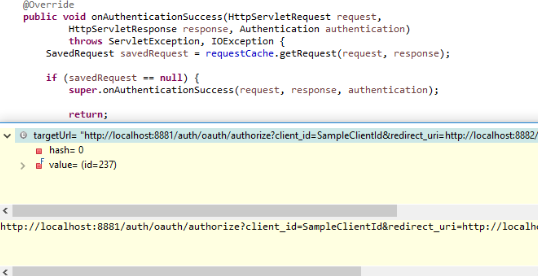
AuthorizationEndpoint.authorize()
根據路徑匹配 /oauth/authorize,AuthorizationEndpoint 的 authorize 介面被呼叫。
@RequestMapping(value = "/oauth/authorize")
public ModelAndView authorize(Map<String, Object> model, @RequestParam Map<String, String> parameters,
SessionStatus sessionStatus, Principal principal) {
AuthorizationRequest authorizationRequest = getOAuth2RequestFactory().createAuthorizationRequest(parameters);
Set<String> responseTypes = authorizationRequest.getResponseTypes();try { ClientDetails client = getClientDetailsService().loadClientByClientId(authorizationRequest.getClientId()); // The resolved redirect URI is either the redirect_uri from the parameters or the one from // clientDetails. Either way we need to store it on the AuthorizationRequest. String redirectUriParameter = authorizationRequest.getRequestParameters().get(OAuth2Utils.REDIRECT_URI); String resolvedRedirect = redirectResolver.resolveRedirect(redirectUriParameter, client); authorizationRequest.setRedirectUri(resolvedRedirect); // We intentionally only validate the parameters requested by the client (ignoring any data that may have // been added to the request by the manager). oauth2RequestValidator.validateScope(authorizationRequest, client); // Some systems may allow for approval decisions to be remembered or approved by default. Check for // such logic here, and set the approved flag on the authorization request accordingly. authorizationRequest = userApprovalHandler.checkForPreApproval(authorizationRequest, (Authentication) principal); // TODO: is this call necessary? boolean approved = userApprovalHandler.isApproved(authorizationRequest, (Authentication) principal); authorizationRequest.setApproved(approved); // Validation is all done, so we can check for auto approval... if (authorizationRequest.isApproved()) { if (responseTypes.contains("token")) { return getImplicitGrantResponse(authorizationRequest); } if (responseTypes.contains("code")) { return new ModelAndView(getAuthorizationCodeResponse(authorizationRequest, (Authentication) principal)); } } // Store authorizationRequest AND an immutable Map of authorizationRequest in session // which will be used to validate against in approveOrDeny() model.put(AUTHORIZATION_REQUEST_ATTR_NAME, authorizationRequest); model.put(ORIGINAL_AUTHORIZATION_REQUEST_ATTR_NAME, unmodifiableMap(authorizationRequest)); return getUserApprovalPageResponse(model, authorizationRequest, (Authentication) principal); } }
DefaultOAuth2RequestFactory.createAuthorizationRequest()
DefaultOAuth2RequestFactory 的 createAuthorizationRequest 方法被呼叫,用來建立 AuthorizationRequest。
public AuthorizationRequest createAuthorizationRequest(Map<String, String> authorizationParameters) {
// 構造 AuthorizationRequest
String clientId = authorizationParameters.get(OAuth2Utils.CLIENT_ID);
String state = authorizationParameters.get(OAuth2Utils.STATE);
String redirectUri = authorizationParameters.get(OAuth2Utils.REDIRECT_URI);
Set<String> responseTypes = OAuth2Utils.parseParameterList(authorizationParameters.get(OAuth2Utils.RESPONSE_TYPE));
Set<String> scopes = extractScopes(authorizationParameters, clientId); AuthorizationRequest request = new AuthorizationRequest(authorizationParameters, Collections.<String, String> emptyMap(), clientId, scopes, null, null, false, state, redirectUri, responseTypes); // 通過 ClientDetailsService 載入 ClientDetails ClientDetails clientDetails = clientDetailsService.loadClientByClientId(clientId); request.setResourceIdsAndAuthoritiesFromClientDetails(clientDetails); return request; }
ClientDetailsService.loadClientByClientId()
ClientDetailsService 的 loadClientByClientId 方法被呼叫,框架提供了 ClientDetailsService 的兩種實現 InMemoryClientDetailsService 和 JdbcClientDetailsService,分別對應從記憶體獲取和從資料庫獲取,當然你也可以根據需要定製其他獲取方式。
JdbcClientDetailsService 的大致實現,主要是通過 JdbcTemplate 獲取,需要設定一個 datasource。
public ClientDetails loadClientByClientId(String clientId) throws InvalidClientException {
ClientDetails details;
try {
details = jdbcTemplate.queryForObject(selectClientDetailsSql, new ClientDetailsRowMapper(), clientId);
}
catch (EmptyResultDataAccessException e) {
throw new NoSuchClientException("No client with requested id: " + clientId);
}
return details; }
InMemoryClientDetailsService 的大致實現,主要是從記憶體Store裡面取出資訊。
public ClientDetails loadClientByClientId(String clientId) throws ClientRegistrationException {
ClientDetails details = clientDetailsStore.get(clientId);
if (details == null) {
throw new NoSuchClientException("No client with requested id: " + clientId);
}
return details;
}
AuthorizationEndpoint.authorize()
繼續回到 AuthorizationEndpoint 的 authorize 方法
@RequestMapping(value = "/oauth/authorize")
public ModelAndView authorize(Map<String, Object> model, @RequestParam Map<String, String> parameters,
SessionStatus sessionStatus, Principal principal) {
AuthorizationRequest authorizationRequest = getOAuth2RequestFactory().createAuthorizationRequest(parameters);
Set<String> responseTypes = authorizationRequest.getResponseTypes();try { // 建立ClientDtails ClientDetails client = getClientDetailsService().loadClientByClientId(authorizationRequest.getClientId()); // The resolved redirect URI is either the redirect_uri from the parameters or the one from // 設定跳轉URL String redirectUriParameter = authorizationRequest.getRequestParameters().get(OAuth2Utils.REDIRECT_URI); String resolvedRedirect = redirectResolver.resolveRedirect(redirectUriParameter, client); authorizationRequest.setRedirectUri(resolvedRedirect); // 驗證授權範圍 oauth2RequestValidator.validateScope(authorizationRequest, client); // 檢查是否是自動完成授權還是轉到授權頁面讓使用者手動確認 authorizationRequest = userApprovalHandler.checkForPreApproval(authorizationRequest, (Authentication) principal); // TODO: is this call necessary? boolean approved = userApprovalHandler.isApproved(authorizationRequest, (Authentication) principal); authorizationRequest.setApproved(approved); // Validation is all done, so we can check for auto approval... if (authorizationRequest.isApproved()) {
if (responseTypes.contains("token")) { return getImplicitGrantResponse(authorizationRequest); } if (responseTypes.contains("code")) {
// 如果是授權碼模式,且為自動授權或已完成授權,直接返回授權結果 return new ModelAndView(getAuthorizationCodeResponse(authorizationRequest, (Authentication) principal)); } } // Store authorizationRequest AND an immutable Map of authorizationRequest in session // which will be used to validate against in approveOrDeny() model.put(AUTHORIZATION_REQUEST_ATTR_NAME, authorizationRequest); model.put(ORIGINAL_AUTHORIZATION_REQUEST_ATTR_NAME, unmodifiableMap(authorizationRequest)); return getUserApprovalPageResponse(model, authorizationRequest, (Authentication) principal); } }
如果是需要手動授權,轉到授權頁面URL: /oauth/confirm_access 。
private ModelAndView getUserApprovalPageResponse(Map<String, Object> model,
AuthorizationRequest authorizationRequest, Authentication principal) {
if (logger.isDebugEnabled()) {
logger.debug("Loading user approval page: " + userApprovalPage);
}
model.putAll(userApprovalHandler.getUserApprovalRequest(authorizationRequest, principal));
// 轉到授權頁面, URL /oauth/confirm_access
return new ModelAndView(userApprovalPage, model);
}
使用者手動授權頁面

AuthorizationEndpoint.approveOrDeny()
AuthorizationEndpoint 中 POST 請求的介面 /oauth/authorize 對應的 approveOrDeny 方法被呼叫 。
@RequestMapping(value = "/oauth/authorize", method = RequestMethod.POST, params = OAuth2Utils.USER_OAUTH_APPROVAL)
public View approveOrDeny(@RequestParam Map<String, String> approvalParameters, Map<String, ?> model,
SessionStatus sessionStatus, Principal principal) {
AuthorizationRequest authorizationRequest = (AuthorizationRequest) model.get(AUTHORIZATION_REQUEST_ATTR_NAME);
try {
Set<String> responseTypes = authorizationRequest.getResponseTypes(); authorizationRequest.setApprovalParameters(approvalParameters); authorizationRequest = userApprovalHandler.updateAfterApproval(authorizationRequest, (Authentication) principal); boolean approved = userApprovalHandler.isApproved(authorizationRequest, (Authentication) principal); authorizationRequest.setApproved(approved); if (!authorizationRequest.isApproved()) {
// 使用者不許授權,拒絕訪問 return new RedirectView(getUnsuccessfulRedirect(authorizationRequest, new UserDeniedAuthorizationException("User denied access"), responseTypes.contains("token")), false, true, false); } // 使用者授權完成,跳轉到客戶端設定的重定向URL return getAuthorizationCodeResponse(authorizationRequest, (Authentication) principal); } }
使用者授權完成,跳轉到客戶端設定的重定向URL。

BasicAuthenticationFilter.doFilterInternal()
轉到客戶端重定向URL之後,BasicAuthenticationFilter 攔截到請求, doFilterInternal 方法被呼叫,攜帶資訊在客戶端執行登入認證。
@Override
protected void doFilterInternal(HttpServletRequest request, HttpServletResponse response, FilterChain chain)
throws IOException, ServletException {
String header = request.getHeader("Authorization");
try { String[] tokens = extractAndDecodeHeader(header, request); assert tokens.length == 2; String username = tokens[0];
if (authenticationIsRequired(username)) { UsernamePasswordAuthenticationToken authRequest = new UsernamePasswordAuthenticationToken(username, tokens[1]); authRequest.setDetails(this.authenticationDetailsSource.buildDetails(request));
Authentication authResult = this.authenticationManager.authenticate(authRequest); SecurityContextHolder.getContext().setAuthentication(authResult); this.rememberMeServices.loginSuccess(request, response, authResult); onSuccessfulAuthentication(request, response, authResult); } } chain.doFilter(request, response); }
如上面程式碼顯示,doFilterInternal 方法中客戶端登入認證邏輯也走了一遍,詳細過程跟上面授權服務端的認證過程一般無二,這裡就不貼重複程式碼,大致流程如下連結流所示:
ProviderManager.authenticate() -- > AbstractUserDetailsAuthenticationProvider.authenticate() --> DaoAuthenticationProvider.retrieveUser() --> ClientDetailsUserDetailsService.loadUserByUsername() --> AbstractUserDetailsAuthenticationProvider.createSuccessAuthentication()
TokenEndpoint.postAccessToken()
認證成功之後,客戶端獲取了許可權憑證,返回客戶端URL,被 OAuth2ClientAuthenticationProcessingFilter 攔截,然後攜帶授權憑證向授權伺服器發起形如: http://localhost:8881/auth/oauth/token 的 Post 請求換取訪問 token,對應的是授權伺服器的 TokenEndpoint 類的 postAccessToken 方法。
@RequestMapping(value = "/oauth/token", method=RequestMethod.POST)
public ResponseEntity<OAuth2AccessToken> postAccessToken(Principal principal, @RequestParam
Map<String, String> parameters) throws HttpRequestMethodNotSupportedException {
// 獲取之前的請求資訊,並對token獲取請求資訊進行校驗
String clientId = getClientId(principal);
ClientDetails authenticatedClient = getClientDetailsService().loadClientByClientId(clientId); TokenRequest tokenRequest = getOAuth2RequestFactory().createTokenRequest(parameters, authenticatedClient);if (authenticatedClient != null) { oAuth2RequestValidator.validateScope(tokenRequest, authenticatedClient); } if (!StringUtils.hasText(tokenRequest.getGrantType())) { throw new InvalidRequestException("Missing grant type"); } if (tokenRequest.getGrantType().equals("implicit")) { throw new InvalidGrantException("Implicit grant type not supported from token endpoint"); } ...
// 生成 token 並返回給客戶端,客戶端就可攜帶此 token 向資源伺服器獲取資訊了 OAuth2AccessToken token = getTokenGranter().grant(tokenRequest.getGrantType(), tokenRequest);return getResponse(token); }
TokenGranter.grant()
令牌的生成通過 TokenGranter 的 grant 方法來完成。根據授權方式的型別,分別有對應的 TokenGranter 實現,如我們使用的授權碼模式,對應的是 AuthorizationCodeTokenGranter。

AbstractTokenGranter.grant()
AuthorizationCodeTokenGranter 的父類 AbstractTokenGranter 的 grant 方法被呼叫。
public OAuth2AccessToken grant(String grantType, TokenRequest tokenRequest) {
if (!this.grantType.equals(grantType)) {
return null;
}
String clientId = tokenRequest.getClientId();
ClientDetails client = clientDetailsService.loadClientByClientId(clientId);
validateGrantType(grantType, client);
if (logger.isDebugEnabled()) { logger.debug("Getting access token for: " + clientId); } return getAccessToken(client, tokenRequest); } protected OAuth2AccessToken getAccessToken(ClientDetails client, TokenRequest tokenRequest) { return tokenServices.createAccessToken(getOAuth2Authentication(client, tokenRequest)); }
DefaultTokenServices.createAccessToken()
DefaultTokenServices 的 createAccessToken 被呼叫,用來生成 token。
@Transactional
public OAuth2AccessToken createAccessToken(OAuth2Authentication authentication) throws AuthenticationException {
// 先從 Store 獲取,Sotre 型別有 InMemoryTokenStore、JdbcTokenStore、JwtTokenStore、RedisTokenStore 等
OAuth2AccessToken existingAccessToken = tokenStore.getAccessToken(authentication);
OAuth2RefreshToken refreshToken = null;
if (existingAccessToken != null) {
if (existingAccessToken.isExpired()) { if (existingAccessToken.getRefreshToken() != null) { refreshToken = existingAccessToken.getRefreshToken(); // The token store could remove the refresh token when the // access token is removed, but we want to be sure... tokenStore.removeRefreshToken(refreshToken); } tokenStore.removeAccessToken(existingAccessToken); } else { // Re-store the access token in case the authentication has changed tokenStore.storeAccessToken(existingAccessToken, authentication); return existingAccessToken; } } // Only create a new refresh token if there wasn't an existing one associated with an expired access token. // Clients might be holding existing refresh tokens, so we re-use it in the case that the old access token expired. if (refreshToken == null) { refreshToken = createRefreshToken(authentication); } // But the refresh token itself might need to be re-issued if it has expired. else if (refreshToken instanceof ExpiringOAuth2RefreshToken) { ExpiringOAuth2RefreshToken expiring = (ExpiringOAuth2RefreshToken) refreshToken; if (System.currentTimeMillis() > expiring.getExpiration().getTime()) { refreshToken = createRefreshToken(authentication); } } OAuth2AccessToken accessToken = createAccessToken(authentication, refreshToken); tokenStore.storeAccessToken(accessToken, authentication); // In case it was modified refreshToken = accessToken.getRefreshToken(); if (refreshToken != null) { tokenStore.storeRefreshToken(refreshToken, authentication); } return accessToken; }
private OAuth2AccessToken createAccessToken(OAuth2Authentication authentication, OAuth2RefreshToken refreshToken) { DefaultOAuth2AccessToken token = new DefaultOAuth2AccessToken(UUID.randomUUID().toString()); int validitySeconds = getAccessTokenValiditySeconds(authentication.getOAuth2Request()); if (validitySeconds > 0) { token.setExpiration(new Date(System.currentTimeMillis() + (validitySeconds * 1000L))); } token.setRefreshToken(refreshToken); token.setScope(authentication.getOAuth2Request().getScope()); return accessTokenEnhancer != null ? accessTokenEnhancer.enhance(token, authentication) : token; }
客戶端攜帶Token訪問資源
token 被生成後返回給了客戶端,客戶端攜帶此 token 發起形如: http://localhost:8881/auth/user 的請求獲取使用者資訊。
OAuth2AuthenticationProcessingFilter 過濾器攔截請求,然後呼叫 OAuth2AuthenticationManager 的 authenticate 方法執行登入流程。
OAuth2AuthenticationProcessingFilter.doFilter()
public void doFilter(ServletRequest req, ServletResponse res, FilterChain chain) throws IOException,
ServletException {
final boolean debug = logger.isDebugEnabled();
final HttpServletRequest request = (HttpServletRequest) req;
final HttpServletResponse response = (HttpServletResponse) res;
try {
// 獲取並校驗 token 之後,然後攜帶 token 進行登入
Authentication authentication = tokenExtractor.extract(request); ...
else { request.setAttribute(OAuth2AuthenticationDetails.ACCESS_TOKEN_VALUE, authentication.getPrincipal()); if (authentication instanceof AbstractAuthenticationToken) { AbstractAuthenticationToken needsDetails = (AbstractAuthenticationToken) authentication; needsDetails.setDetails(authenticationDetailsSource.buildDetails(request)); }
Authentication authResult = authenticationManager.authenticate(authentication); if (debug) { logger.debug("Authentication success: " + authResult); } eventPublisher.publishAuthenticationSuccess(authResult); SecurityContextHolder.getContext().setAuthentication(authResult); } } chain.doFilter(request, response); }
OAuth2AuthenticationManager.authenticate()
OAuth2AuthenticationManager 的 authenticate 方法被呼叫,利用 token 執行登入認證。
public Authentication authenticate(Authentication authentication) throws AuthenticationException {
if (authentication == null) {
throw new InvalidTokenException("Invalid token (token not found)");
}
String token = (String) authentication.getPrincipal();
OAuth2Authentication auth = tokenServices.loadAuthentication(token);
if (auth == null) { throw new InvalidTokenException("Invalid token: " + token); } Collection<String> resourceIds = auth.getOAuth2Request().getResourceIds(); if (resourceId != null && resourceIds != null && !resourceIds.isEmpty() && !resourceIds.contains(resourceId)) { throw new OAuth2AccessDeniedException("Invalid token does not contain resource id (" + resourceId + ")"); } checkClientDetails(auth); if (authentication.getDetails() instanceof OAuth2AuthenticationDetails) { OAuth2AuthenticationDetails details = (OAuth2AuthenticationDetails) authentication.getDetails(); // Guard against a cached copy of the same details if (!details.equals(auth.getDetails())) { // Preserve the authentication details from the one loaded by token services details.setDecodedDetails(auth.getDetails()); } } auth.setDetails(authentication.getDetails()); auth.setAuthenticated(true); return auth; }
認證成功之後,獲取目標介面資料,然後重定向了真正的訪問目標URL http://localhost:8882/securedPage,並資訊獲取的資料資訊。
訪問 http://localhost:8882/securedPage,返回結果如下:

訪問 http://localhost:8883/securedPage,返回結果如下:
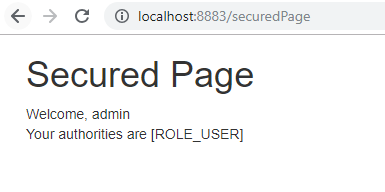
另外,在客戶端訪問受保護的資源的時候,會被 OAuth2ClientAuthenticationProcessingFilter 過濾器攔截。
OAuth2ClientAuthenticationProcessingFilter 的主要作用是獲取 token 進行登入認證。
此時可能會出現以下幾種情況:
1. 獲取不到之前儲存的 token,或者 token 已經過期,此時會繼續判斷請求中是否攜帶從認證伺服器獲取的授權

